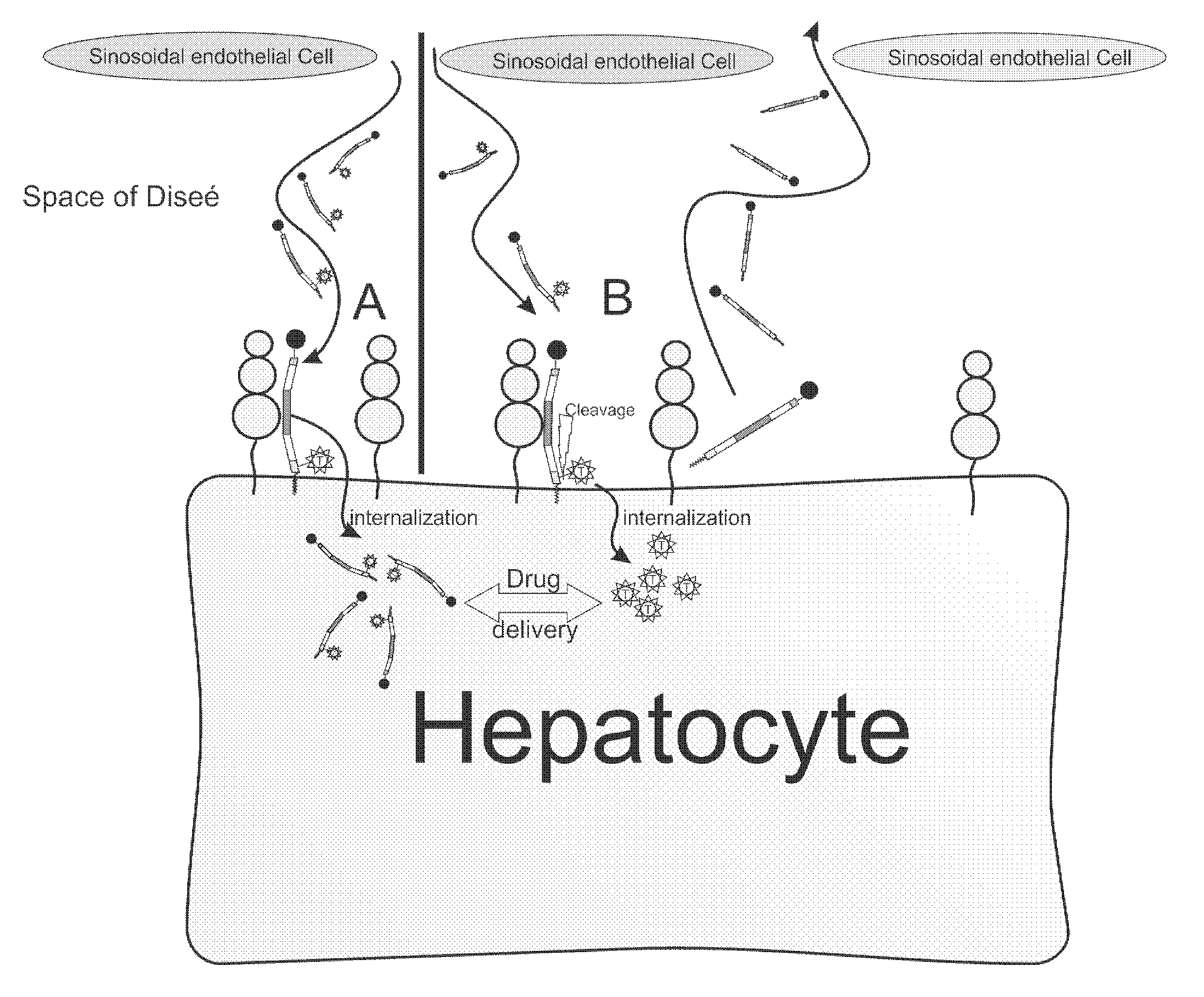Hydrophobic modified peptides and their use for liver specific targeting
- Summary
- Abstract
- Description
- Claims
- Application Information
AI Technical Summary
Benefits of technology
Problems solved by technology
Method used
Image
Examples
example 1
Synthesis of the Hydrophobic Modified Peptide
[0173]The synthesis of the peptides was carried out by using the Fmoc method as described in (10) Gripon, P. et al. J Virol 79, 1613-1622 (2005).
Synthesis DOTA-DFP
[0174]Diisopropylcarbodiimide (5 mmol, 631 mg, 774 μl) was dissolved in pyridine (15 ml) and dropped over 10 min to a solution of DOTA (5 mmol, 2.02 g) and difluoro phenole (5 mmol, 650 mg) in water (60 ml) while stirring. 30 min after addition, the reaction mixture was extracted three times with dichlormethane and the aqueous phase was evaporated to dryness by using a rotating evaporator. The crude product was dissolved in a mixture of water (11 ml) and acetonitrile (3 ml) and was purified via preparative RP-HPLC. The HPLC fractions containing the product were concentrated by lyophilisation. Yield: 1.0633 g (41%).
[0175]The peptide stearoyl-KKKNLSTSNPLGFFPDHQLDP-amide (140 mg, 0.055 mmol) was dissolved in 5 ml DMF. DOTA-DFP (129 mg, 0.25 mmol) was added an...
example 2
Imaging in PET
[0177]The peptide stearoyl-[K(DOTA[68Ga])]3-NLSTSNPLGFFPDHQLDP-amide was dissolved in citrate buffer (pH 8.0)+4% BSA and injected i.v. in the tail vene of tumour bearing WAG / Rij rats. The rats were orthopically injected with 1×106 syngenic colon carcinoma cells (CC531 cells) 10 days prior to the measurements. At the day of measurement the rats received the peptide in a concentration of 400 nmol / kg body weight. During the experiments the rats were anaesthetised by isoflurane and kept at 37° C. PET imaging was performed using a Inveon small animal PET from Siemens, imaging was started immediately after i.v. injection of the peptide 24h after the initial measurement using stearoyl-[K(DOTA[68Ga])]3-NLSTSNPLGFFPDHQLDP-amide the rats were injected with 18F-FDG (Fluodeoxyglucose(18F) in a concentration of 5 millicuries as a control. FIG. 4A-C shows a representative PET image of a tumor bearing rat. FIG. 4A Specific enrichment of 400 nmol / kg stearoyl-[K(DOTA[68Ga])]3-NLSTSNPLG...
example 3
Test of Liver Specificity and Cytotoxicity of N-Terminally Modified preS Peptides Coupled with Doxorubicin
[0178]Doxorubicin coupled peptides have been synthesized as described herein. Briefly, FMOC protected solid phase peptide synthesis was used to synthesize the peptide backbone (KNLSTSNPLGFFPDHQLDPy), Doxorubicin was then coupled to the peptide backbone using amid formation. The “y” in the peptide backbone represents D-tyrosine to which 131 Iodine can be coupled to act as a label for detecting the modified peptide in rats. The resulting peptide was purified by HPLC and purity was analyzed by Mass Spectrometry. Purity of the resulting peptide was 97% or higher.
[0179]A sketch of the modified peptide is shown below:
Myristoyl-[K-Doxorubicin]-NLSTSNPLGFFPDHQLDPy-amide (HBVpreS / myr-[K-Doxorubicin]3-20y)
[0180]In order to show that the resulting synthesized peptides was still liver specific, the above sketched peptide was labeled C-terminally with radioactive 131 Iodine using the chloram...
PUM
| Property | Measurement | Unit |
|---|---|---|
| Capacitance | aaaaa | aaaaa |
| Molality | aaaaa | aaaaa |
| Molality | aaaaa | aaaaa |
Abstract
Description
Claims
Application Information
 Login to View More
Login to View More - R&D
- Intellectual Property
- Life Sciences
- Materials
- Tech Scout
- Unparalleled Data Quality
- Higher Quality Content
- 60% Fewer Hallucinations
Browse by: Latest US Patents, China's latest patents, Technical Efficacy Thesaurus, Application Domain, Technology Topic, Popular Technical Reports.
© 2025 PatSnap. All rights reserved.Legal|Privacy policy|Modern Slavery Act Transparency Statement|Sitemap|About US| Contact US: help@patsnap.com



